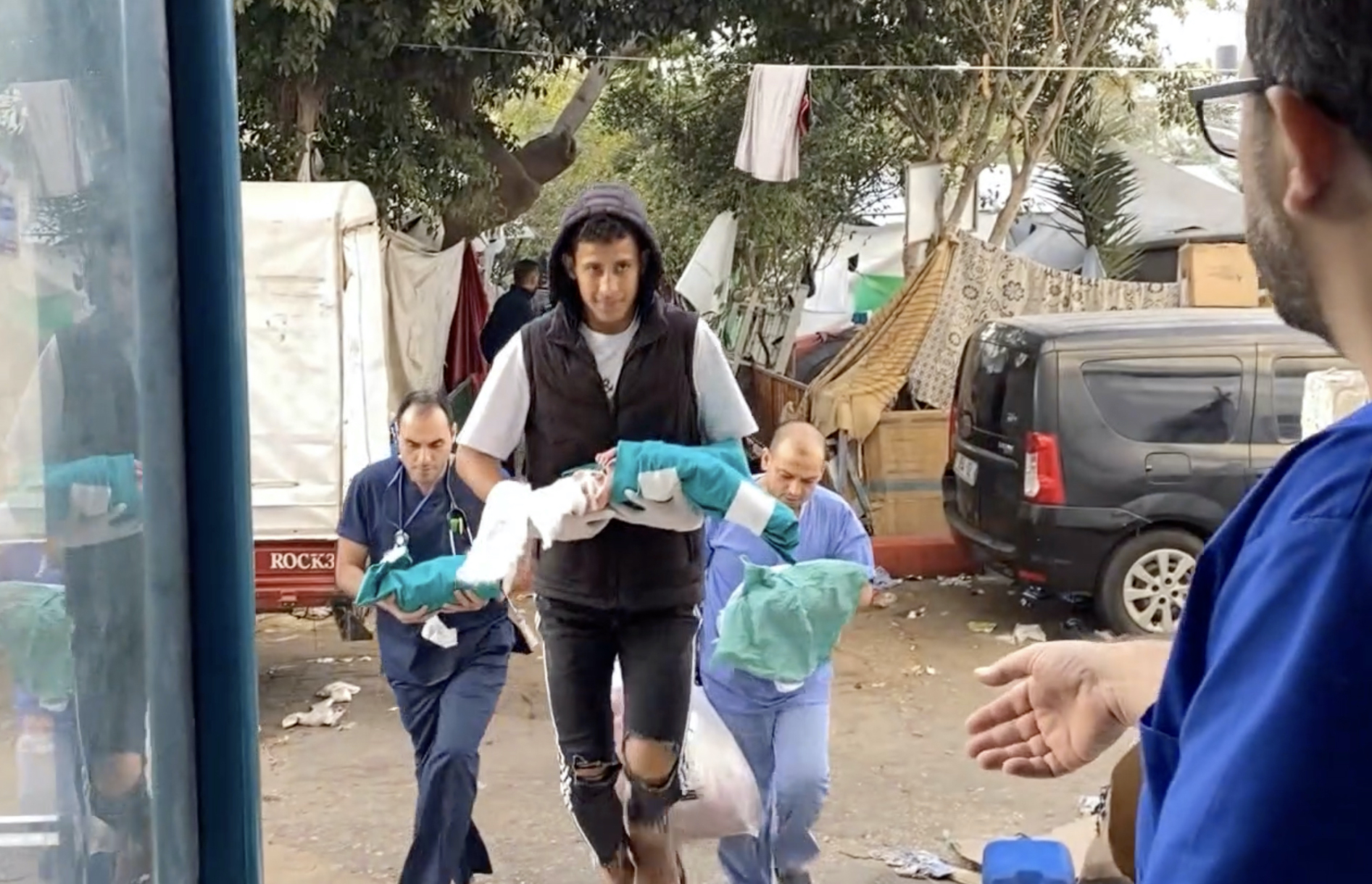As bombs keep falling on Gaza, it has become exceedingly difficult to keep up with the excuses used to justify the killing of over 11,000 people, some 4,600 of them children. In a deliberate constriction of information, Israel has made it unsafe to report the truth. As of Nov. 15, 42 journalists have been killed, most of them victims of Israeli airstrikes. Without these reporters to provide firsthand accounts, the Israeli military and government feed propaganda to willing parties in Western media almost unchallenged.
There was the claim of 40 beheaded babies that both the IDF and White House eventually walked back, and the denial of the use of white phosphorus that Human Rights Watch confirmed. A supposed nurse in Gaza recorded a frantic video in which she claimed that Hamas was stealing supplies and fuel; the video turned out to be completely fabricated. The Israeli military used a photo of an elderly Palestinian man to illustrate how it was giving safe passage to civilians; his granddaughter said that shortly afterward he was fatally shot in the head and back.
This week, IDF spokesperson Daniel Hagari filmed a tour of Al-Rantisi Children’s Hospital in Gaza City to show the world that there had been hostages and terrorists in its basement. His proof: diapers, a baby bottle, a chair with a hospital gown, and a rope—items that wouldn’t be out of place in a hospital. His final piece of evidence was a supposed Hamas-constructed list “where every terrorist writes his name,” Hagari said. Viewers familiar with Arabic noticed that the piece of paper was actually just a calendar listing the days of the week.
One of Israel’s most consistent claims has been that Al-Shifa Hospital, the largest medical complex in the Gaza Strip, sat above an underground Hamas command center housing Israeli hostages, and it was imperative for hospitalized Palestinians to be expelled so that the IDF could raid it. Al-Shifa had already run out of most of its supplies over the past weekend, and was housing 39 premature babies who needed to be moved from their non-functioning incubators to another part of the facility. "Yesterday I had 39 babies and today they have become 36," Dr. Mohamed Tabasha, the head of the pediatric unit at Al-Shifa, told Reuters on Monday.
These needless and predictable deaths were supposedly justified because Israel would rescue civilians and strike a blow at Hamas. After two days, the IDF said it had recovered the body of one hostage, a 65-year-old woman, in a building near Al-Shifa. The revealed bounty from the hospital raid was approximately 15 guns, a few vests, cans of WD-40, and a box of dates. There were also “grab bags,” which naturally brings up the question of why these fleeing Hamas soldiers, with plenty of warning, didn’t take their already-packed gear. The photo op was reminiscent of every time an American police department spaces out all the bags of dirt weed on a table after an underwhelming drug bust. On Thursday, an IDF spokesperson said that there was no more publishable evidence from the raid to be released at this time. On Friday, hospital director Muhammed Abu Salmiya said everyone in the ICU had died after running out of oxygen.
Ultimately it didn’t matter what the IDF found or didn’t find in Al-Shifa. The oppressor controls the narrative and thus gets the benefit of the doubt. The intent of these claims—and there are many more, and not just from this past month—is to display the sheer audacity of making them, secure in the knowledge that the usual fish will bite. And plenty of credulous outlets have no second thoughts about disseminating propaganda. Earlier this week, CNN aired a segment in which correspondent Nic Robertson embedded with the IDF as they drove through Gaza and toured Al-Rantisi Hospital. (The network quietly edited out parts of the report days later.) Without scrutiny, Robertson passed along the details of the phony terrorist list, the sinister chair, a surprise knife on the floor. The tour resembled a low-effort haunted house. “It is clear,” Robertson said without a trace of irony, “[Hagari] wants this story told.”
Every column inch or minute of airtime telling Israel’s story takes away space for Gaza’s. That’s no accident. When journalists on the ground aren’t being killed or wounded, they are being arrested, assaulted, threatened, or defamed. The Israeli government baselessly accused freelance photographers of having prior knowledge of the Oct. 7 attack by Hamas, setting the pretense for killing more media members. “Journalists found to have known about the massacre, and still chose to stand as idle bystanders while children were slaughtered—are no different than terrorists and should be treated as such,” Israeli politician Benny Gantz said. This accusation stemmed from unfounded speculation by Gil Hoffman, executive director of the incredibly named Honest Reporting, a Zionist media watchdog group. When reached by journalists asking for sources for that speculation, Hoffman said he was only “raising questions.”
The press traditionally defends its own. Recall when Donald Trump was president, and he would disparage a journalist at a press briefing, then reporters would circle the wagons and speak loudly in opposition. Where is that volume now? Some voices can be heard, at least: On Nov. 9, a group of primarily U.S.-based journalists published an open letter calling on “Western newsroom leaders to be clear-eyed in coverage of Israel’s repeated atrocities against Palestinians.” The ad hoc coalition Writers Against the War on Gaza had published their own letter a couple of weeks earlier. “We condemn those in our industries who continue to enable apartheid and genocide,” the letter read. The death toll in Gaza when that letter was printed was barely half of where it stands today.
The solidarity in numbers still does not preclude some of those voices from paying a price. Because New York Times Magazine writer Jazmine Hughes signed the WAWOG letter, she was forced to resign from her job, without severance. Jamie Lauren Keiles, who contributed to the magazine but was not covered by a union contract, signed the letter and quit around the same time, although he said it wasn’t for the same reason: “I resigned from my contributor writing position at the Times Mag earlier this week because having a formal institutional affiliation was starting to become a liability to my work.”
There is palpable tension within the media industry. From friends and colleagues I’ve heard stories of arguments, reprimands, and decisions overridden by management. Earlier this month Hearst encouraged employees to snitch on a colleague if they had made a “controversial statement on a hot-button issue,” or even if they had liked or retweeted something that could be considered controversial. Staffers at the Los Angeles Times who signed the Nov. 9 open letter condemning Israel for killing journalists and threatening newsgathering operations have been told they are prohibited from covering the conflict for the next three months. Some stories get told and others don't.
The reality is that people don’t want to be fired, so they deploy the passive voice to absolve themselves from criticism or discipline. That’s how you get a New York Times headline like “Explosion Gazans Say Was Airstrike Leaves Many Casualties in Dense Neighborhood.” But while journalists fret over the way to describe a military airstrike that killed civilians, that policy of strict objectivity only ever seems to go one way. The March for Israel, which featured a televangelist who once said that God allowed Hitler to orchestrate the Holocaust so that the Jewish people could have Israel, does not receive the same scrutiny as pro-Palestinian demonstrations on college campuses. MSNBC allows the Anti-Defamation League’s Jonathan Greenblatt to sit in the studio and call for the IRS and FBI to investigate pro-Palestinian student groups. Numerous company executives, including Condé Nast CEO Roger Lynch, attend a screening of edited Oct. 7 footage of Hamas killing Israelis then tell their employees to be careful of what they say.
As many news outlets fail in their mission of informing, the silver lining is that they are also failing in their mission of persuading. The majority of Americans polled want a ceasefire. There is pushback, online and in the streets, against the Israeli government’s propaganda. It used to work, relying on a willingness to believe authority, and a reluctance to learn anything about Palestinians. But it's heartening to see that there are journalists and everyday people who do not believe that a baby bottle in a basement is justification to kill more hospitalized civilians.
But the Israeli government and military know they can't explicitly state that their ultimate goal to wipe out Palestinians and occupy more land. Northern Gaza is razed, and already they are making moves to expand the invasion to southern Gaza, dropping leaflets on neighborhoods and insinuating that Hamas is there now. They will continue to lie, but that doesn't mean anyone else has to take it as truth.






